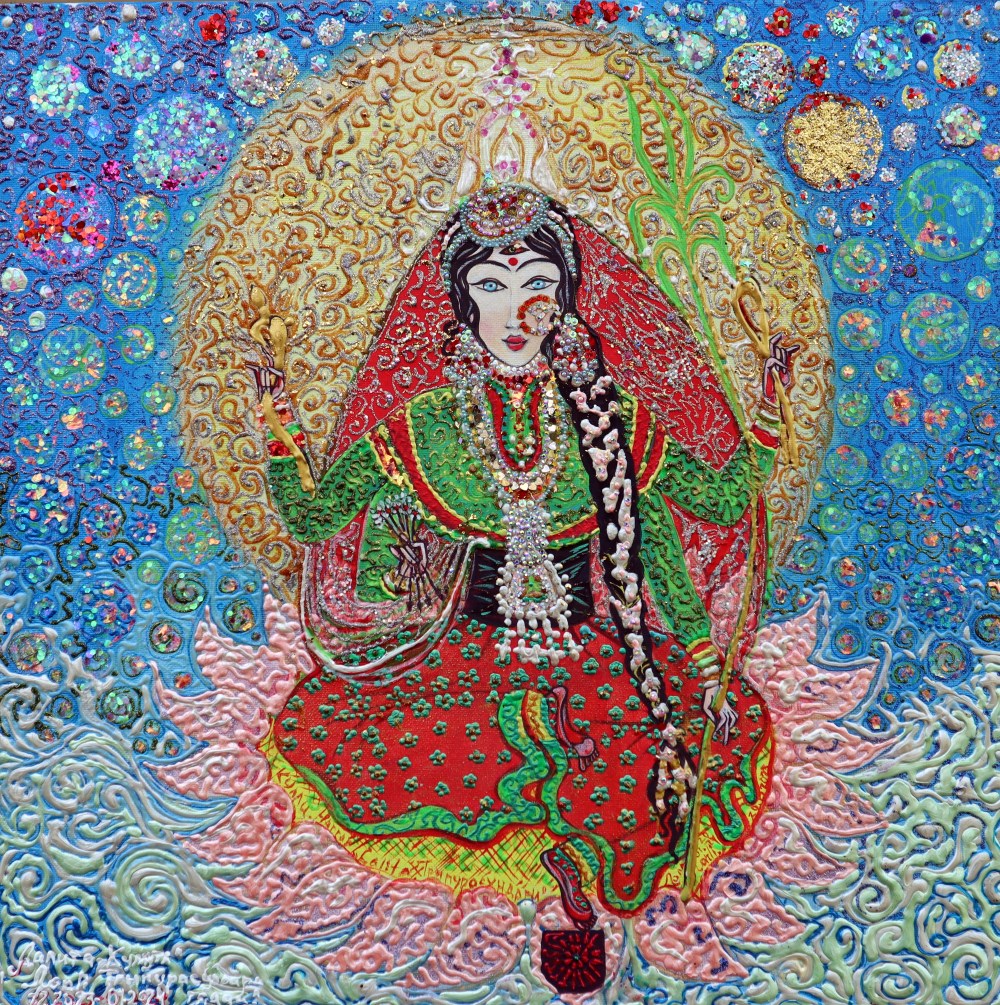Legends of supreme world
Lalita-Kuluta Tripurasundari-Gaddi
Tempera, acrylic and minerals on canvas. 2024. 40 x 40 cm

The painting depicts the Mother of the World in her royal position. This is indicated by the names Lalita and Tripurasundari in the title of the painting. This beautiful goddess is deeply revered in the Kullu Valley, where the estate of the great Russian artist N.K. Roerich is located.
Kuluta is the ancient name of the valley used by the Gaddi people living in the valley. Lalita - Kuluta means Lalita from Kullu. In the painting, the goddess is depicted in the festive attire of the Gaddi people, and with the appearance features characteristic of this people. And also with certain special features that are considered the highest beauty among these mountain people. Although the outfit is quite earthly, the goddess is depicted with the canonical position of her arms and legs and with objects that symbolize her essence: a bow made of soft and sweet reeds, 5 arrows made of flowers, a golden goad without a sharp end, a hoop loop made of sweet dough.
How do I understand this? The strength of this Shakti is gentleness and love; she curbs anger and malice with a smile of tenderness and sweet gifts. She kills on the spot with her enchanting gaze, with the promise of sweet hugs, which is why her bow is made of sugar cane and her arrows are made of flowers. She binds you to herself with love, she drives you with the goad of desire to please Her. The positions of the fingers are mudras; they all mean strengthening the meanings embedded in the objects that the Goddess holds, as well as harmonizing the space around. Tender, affectionate, kind, beloved Tripurasundari.
The planets and stars in the painting glow in the dark without backlighting, illuminating its appearance with a gentle greenish light. The moment is depicted when she moved together her eyebrows for a split second, after which the creation of worlds began. And also the state of balanced position of her mind, kept intact in earthly energies and continuing to create. Her left leg rests on the Kalachakra in a black square, this symbolizes the Universe in a sleeping state, which She awakens to creation with Her touch.
Please read the extracts from the classical texts given below to know more about the beautiful Lalita. Her form is described in her Dhyana Stotra as follows.
“I imagine my goddess Bhavani with the color of the rising sun.
Who has eyes like waves of mercy, who has a bow made of sweet reeds, arrows of soft flowers and Aasha, Ankusha in her hands, and who is surrounded by her devotees with great powers, as the personification of the concept of “Self”.
Also details of her appearance can be found in the famous hymn in her honor, Lalita Sahasranama, where she is said to be sitting on a throne like a queen (names 2 and 3), wearing jewels (names 13 and 14), having the favorable marks of a married woman (names 16–25), heavy chest and thin waist (name 36); a crescent moon adorns her forehead and her smile overwhelms Kamesvara, the lord of desires (name 28). She has the legs of Pancha Brahma (five Brahmas) (name 249) as her throne.
She is often iconographically depicted as a 16-year-old girl (hence the name "Shodashi"), sitting on a lotus, which rests on the supine body of Sadashiva, which, in turn, lies on a throne whose legs are the gods Brahma, Vishnu, Ishvara and Rudra. In some cases, the lotus grows from Shiva's navel. In other, more common cases, the lotus is grown directly from the Sri Chakra.
In the Jnana Khanda of Tripura Rahasya, the goddess herself describes her eternal form.
On the island of jewels, surrounded by an ocean of nectar, beyond the universe, there is a mansion built of Chintamani (wish-granting jewel) in a grove of Kadamba (Burbloom) trees. There is a platform with four legs representing Brahma, Vishnu, Mahesha and Ishwara and the platform itself represents the back of Sadashiva. On it is installed my non-transcendental form of Tripura Sundari in the form of eternal consciousness."
"In the Soundarya Lahari it is mentioned that Brahma, Vishnu and Shiva began their cosmic creation when the Supreme Shakti joined her eyebrows for a split second."
"Tripurasundari. This name says that she is the most beautiful in all three worlds. There are many interpretations of the word “tripura”. The Kalika Purana says that in accordance with the desire for creation and manifestation, Shiva’s body became “triple”, the upper part became Brahma, the middle part became Vishnu and the lower part Rudra. Since these three parts (pura) are in Shiva, he is called Tripura, and his consort Tripura. In Kamakala Vilasa, the sage Abhiyukta mentions that the devi created all three forms, she is in everything and in form of three worlds, and exists after the destruction of these worlds, and after their destruction restores them again. In the Brahmanda Purana, it is mentioned that Devi Tripurasundari rules the universe, she is the supreme queen, and Brahma, Vishnu and Shiva are the performers of her actions in her kingdom.
She is present in three nadis - sushumna, pingala and ida (nadis are energy rays in the body, interconnected with the Universe, central sushumna - the sun ray, pingala and ida - the right and left side, the moon ray, the light and dark side of the moon, deity and shakti, as well as yin-yang), she is the ruler of the three shaktis - ichchha, jnana and kriya (intention, knowledge and action). She penetrates all three worlds - heaven, earth and hell. She is the ruler of all three bodies - sthula, sukshma and karana (gross, subtle and causal). She is present in three states - jagrat, swapna and sushupti (waking, dreaming and deep sleep). It penetrates into all three gunas - sattva, rajas and tamas."

